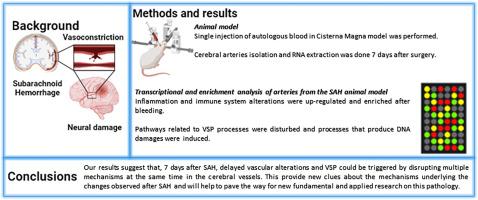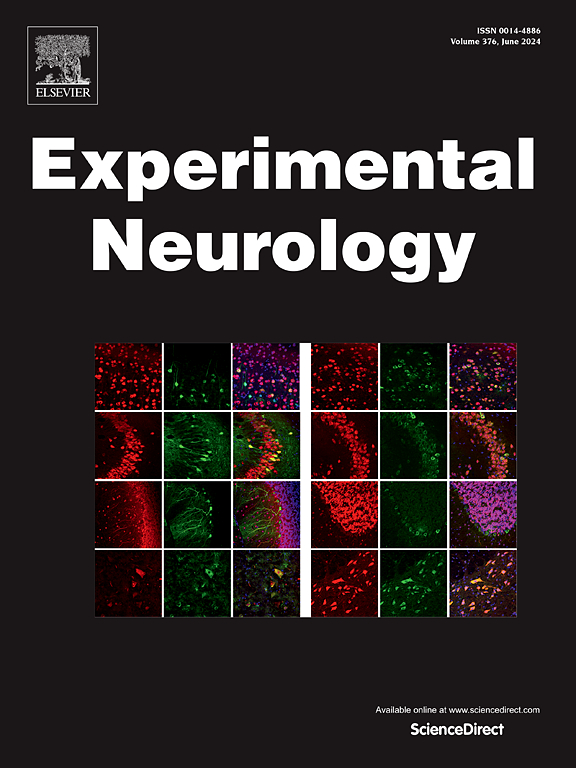大鼠蛛网膜下腔出血模型中脑动脉转录组谱的延迟变化。
IF 4.6
2区 医学
Q1 NEUROSCIENCES
引用次数: 0
摘要
动脉瘤性蛛网膜下腔出血(aSAH)是一种以大脑动脉破裂导致血液进入蛛网膜下腔为特征的神经血管疾病。出血发作后,继发性血管痉挛(VSP)仍然是一个显著的副作用,导致严重的合并症。我们使用微阵列和生物信息学方法分析了SAH大鼠模型中动脉表达谱的变化。我们使用了先前在我们实验室中鉴定的单次注射自体血大鼠模型。我们对手术后7 天的动物脑动脉进行了总RNA提取和微阵列分析,以研究SAH诱导的延迟转录变化。为了评估不同表达基因之间的功能关系,我们运行了基因富集工具的组合:GSEA, ClueGO和ClusterProfiler。我们的研究结果表明,在SAH动物中,与炎症和免疫系统激活相关的基因组上调;与肌肉收缩调控通路相关的基因表达紊乱;与DNA损伤和修复相关的基因类别被过度描述。总之,我们的研究结果表明,在SAH损伤后,多种机制而不是单一原因在脑血管中同时被激活,从而引发血管改变。本文章由计算机程序翻译,如有差异,请以英文原文为准。

Delayed changes in the transcriptomic profile of cerebral arteries in a rat model of subarachnoid hemorrhage
Aneurismal subarachnoid hemorrhage (aSAH) is a neurovascular disease characterized by blood released into the subarachnoid space due to rupture of the cerebral arteries. After the onset of bleeding, secondary associated vasospasm (VSP) remains a dramatic side effect that causes severe comorbidities. We analyzed alterations in the expression profiles of arteries from a rat model of SAH using microarray and bioinformatics approaches. A single injection autologous blood rat model, previously characterized in our laboratory, was used. We performed a total RNA extraction and a microarray analysis of cerebral arteries from animals 7 days after surgery to study the delayed transcriptional changes induced by SAH. To assess the functional relationship between differently expressed genes, we run a combination of gene enrichment tools: GSEA, ClueGO, and ClusterProfiler. Our results showed that in SAH animals, the gene sets related to inflammation and immune system activation were up-regulated; genes related to the pathways involved in the regulation of muscle contraction had their expression disturbed; and the gene categories associated with DNA damage and repair were overrepresented. In conclusion, our results suggest that, after the SAH insult, multiple mechanisms, rather than a single cause, are activated at the same time in the cerebral vessels to trigger vascular alterations.
求助全文
通过发布文献求助,成功后即可免费获取论文全文。
去求助
来源期刊

Experimental Neurology
医学-神经科学
CiteScore
10.10
自引率
3.80%
发文量
258
审稿时长
42 days
期刊介绍:
Experimental Neurology, a Journal of Neuroscience Research, publishes original research in neuroscience with a particular emphasis on novel findings in neural development, regeneration, plasticity and transplantation. The journal has focused on research concerning basic mechanisms underlying neurological disorders.
 求助内容:
求助内容: 应助结果提醒方式:
应助结果提醒方式:


